Evaluation of Composites Reinforced by Processed and Unprocessed Coconut Husk Powder
Abstract
:1. Introduction
2. Materials and Methods
3. Results and Discussion
4. Compressive Testing
5. Impact Testing
6. Thermal Linear Dilatometry Testing
7. Conclusions
- The processing with ball mill reduced the average size and aspect ratio of particulates;
- With smaller particulates, there is an improvement in the wettability and workability, allowing higher amounts of reinforcement to be worked with, increasing the impact and compression strengths;
- The reduction in size improves the dispersion and reduces the agglomeration of particulates;
- With a high amount, 40 vol%, of coconut husk powder, the work temperature for this formulation can be close to melting point, since the glass transition temperature is not observed at dilatometry;
- The finished surface is very smooth, enabling this new composite to be a potential anti-corrosive coating in the near future.
Author Contributions
Funding
Informed Consent Statement
Data Availability Statement
Acknowledgments
Conflicts of Interest
References
- GFN. Country Trends; Global Footprint Network: 2022. Available online: https://data.footprintnetwork.org/?_ga=2.267151694.1702815898.1662328763-1252452559.1662328763#/countryTrends?cn=5001&type=earth (accessed on 2 October 2022).
- Velasco, D.C.R.; Júnior, J.A.T.L.; Lopes, F.P.D.; Vieira, C.M.F.; Azevedo, A.R.G. Potencial econômico e energético do aproveitamento do calor rejeitado por condicionadores de ar. In Engenharia Mecânica—A Influência de Máquinas, Ferramentas e Motores no Cotidiano do Homem 2; Atena Editora: Ponta Grossa, Brazil, 2021; pp. 175–183. [Google Scholar] [CrossRef]
- EIA. Energy Information Administration International Energy Outlook 2021, with Projections to 2050; Energy Information Administration: 2021. Available online: https://www.eia.gov/outlooks/ieo/ (accessed on 2 October 2022).
- Güven, O.; Monteiro, S.N.; Moura, E.A.B.; Drelich, J.W. Re-emerging field of lignocellulosic fiber—Polymer composites and ionizing radiation technology in their formulation. Polym. Rev. 2016, 56, 702–736. [Google Scholar] [CrossRef]
- Marchi, B.Z.; Oliveira, M.S.; Bezerra, W.B.A.; Sousa, T.G.; Candido, V.S.; Silva, A.C.R.; Monteiro, S.N. Ubim fiber (Geonoma baculífera): A less known Brazilian amazon natural fiber for engineering applications. Sustainability 2022, 14, 421. [Google Scholar] [CrossRef]
- Filho, E.G.O.; Luz, F.S.; Fujiyama, R.T.; Silva, A.C.R.; Candido, V.S.; Monteiro, S.N. Effect of chemical treatment and length of raffia fiber (Raphia vinifera) on mechanical stiffening of polyester composites. Polymers 2020, 12, 2899. [Google Scholar] [CrossRef] [PubMed]
- Ribeiro, M.M.; Pinheiro, M.A.; Rodrigues, J.S.; Ramos, R.P.B.; Corrêa, A.C.; Monteiro, S.N.; Silva, A.C.R.; Candido, V.S. Comparison of young’s modulus of continuous and aligned lignocellulosic jute and mallow fibers reinforced polyester composites determined both experimentally and from theoretical prediction models. Polymers 2022, 14, 401. [Google Scholar] [CrossRef]
- Wu, Y.; Xia, C.; Cai, L.; Garcia, A.C.; Shi, S.Q. Development of natural fiber-reinforced composite with comparable mechanical properties and reduced energy consumption and environmental impacts for replacing automotive glass-fiber sheet molding compound. J. Clean. Prod. 2018, 184, 92–100. [Google Scholar] [CrossRef]
- Azevedo, A.R.G.; Cecchin, D.; Luiz, N.F.; Cruz, V.F.; Marvila, M.T.; Zanelato, E.B.; Monteiro, S.N.; Morais, G.; Alexandre, J. Characterization of Clay Mix with Incorporation of Granite Waste for the Production of Ceramic Tiles. In Characterization of Minerals, Metals, and Materials; The Minerals, Metals & Materials Series; Springer: Berlin/Heidelberg, Germany, 2020; pp. 469–475. [Google Scholar] [CrossRef]
- Velasco, D.C.R.; Lopes, F.P.D.; Simonassi, N.T.; Vieira, C.M.F. Influence of the incorporation of waste on the water vapor permeability of epoxide matrix composites. Braz. J. Dev. 2022, 8, 24272–24282. [Google Scholar] [CrossRef]
- Dionizio, A.F.; Vale, A.T.D.; Moreira, A.C.O.; Galvão, L.G.O.; Chaves, B.S.; Costa, M.A. Adding value to agro-industrial waste for energy purposes. Rev. Ciências Agrárias 2019, 42, 528–538. [Google Scholar] [CrossRef]
- Paula, L.E.R.; Trugilho, P.F.; Napoli, A.; Bianchi, M.L. Characterization of residues from plant biomass for use in energy generation. Cerne 2011, 17, 237–246. [Google Scholar] [CrossRef] [Green Version]
- FAO. Food Balances (2010-); Food and Agriculture Organization of the United Nations: 2022. Available online: https://www.fao.org/faostat/en/#data/FBS (accessed on 7 October 2022).
- Martins, A.P.; Sanches, R.A.; da Silva, P.L.R.; Borelli, C.; Watanabe, T.; Marcicano, J.P.P. The post-consumption problem of green coconut in Brazil: Alternatives and sustainability. Sustain. Debate 2016, 7, 44–57. [Google Scholar] [CrossRef]
- FAO. Jute, Kenaf, Sisal, Abaca, Coir and Allied Fibres (Statistical Bulletin 2021); Food and Agriculture Organization of the United Nations: 2022. Available online: https://www.fao.org/3/cc2138en/cc2138en.pdf (accessed on 7 October 2022).
- Nascimento, R.J.M.; Pereira, K.R.A.; Avelino, F. Parametric and modeling studies of rhodamine-b adsorption using coconut coir-based materials as eco-friendly adsorbents. J. Environ. Chem. Eng. 2021, 9, 105943. [Google Scholar] [CrossRef]
- Lindao-Pérez, J.D.; Cedeño, A.J.R.; Villamar-Tores, R.O.; Zapatier Santilán, A.D.; Mera-Pérez, H.A.; Jazayeri, S.M. Production and bromatological analysis of the oyster mushroom (Pleurotus ostreatus (jacq. ex fr.) p. kumm.) grown with cocoa, banana, coconut and African palm husk substrates. Acta Agric. Slovenica 2022, 118, 1–8. [Google Scholar] [CrossRef]
- Kumar, S.; Saha, A. Utilization of coconut shell biomass residue to develop sustainable biocomposites and characterize the physical, mechanical, thermal, and water absorption properties. Biomass Convers. Biorefin. 2022. [Google Scholar] [CrossRef]
- Amrullah, A.; Farobie, O.; Pramono, G.P. Solid degradation and its kinetics on phenol-rich bio-oil production from pyrolysis of coconut shell and lamtoro wood residue. Korean J. Chem. Eng. 2022, 39, 389–397. [Google Scholar] [CrossRef]
- Saejung, C.; Sanusan, W. Valorization of lignocellulosic wastes and nutrient recovery by anoxygenic photosynthetic bacteria. Waste Biomass Valorization 2021, 12, 4835–4844. [Google Scholar] [CrossRef]
- Junior, C.C.S.; Rambo, M.C.D.; Teófilo, R.F.; Cardoso, W.J.; Bertuol, D.A.; Rambo, M.K.D. Production of levulinic acid from coconut residues (Cocos nucifera) using differents approaches. Waste Biomass Valorization 2021, 12, 6875–6886. [Google Scholar] [CrossRef]
- Danso, H.; Manu, D. Influence of coconut fibres and lime on the properties of soil-cement mortar. Case Stud. Constr. Mater. 2020, 12, e00316. [Google Scholar] [CrossRef]
- Nadzri, S.N.I.H.A.; Sultan, M.T.H.; Shah, A.U.M.; Safri, S.N.A.; Talib, A.R.A.; Jawaid, M.; Basri, A.A. A comprehensive review of coconut shell powder composites: Preparation, processing, and characterization. J. Thermoplast. Compos. Mater. 2022, 35, 2641–2664. [Google Scholar] [CrossRef]
- Verma, A.; Budiyal, L.; Sanjay, M.R.; Siengchin, S. Processing and characterization analysis of pyrolyzed oil rubber (from waste tires)-epoxy polymer blend composite for lightweight structures and coatings applications. Polym. Eng. Sci. 2019, 59, 2041–2051. [Google Scholar] [CrossRef]
- Verma, A.; Baurai, K.; Sanjay, M.R.; Siengchin, S. Mechanical, microstructural, and thermal characterization insights of pyrolyzed carbon black from waste tires reinforced epoxy nanocomposites for coating application. Polym. Compos. 2020, 41, 338–349. [Google Scholar] [CrossRef]
- El-Zayat, M.M.; Abdel-Hakim, A.; Mohamed, M.A. Effect of gamma radiation on the physico mechanical properties of recycled HDPE/modified sugarcane bagasse composite. J. Macromol. Sci. Part A 2019, 59, 127–135. [Google Scholar] [CrossRef]
- Abdel-Hakim, A.; Mourad, R.M. Mechanical, water uptake properties, and biodegradability of polystyrene-coated sisal fiber-reinforced high-density polyethylene. Polym. Compos. 2020, 41, 1435–1446. [Google Scholar] [CrossRef]
- Abdel-Hakim, A.; El-Wakil, A.E.-A.A.; El-Mogy, S.; Halim, S. Effect of fiber coating on the mechanical performance, water absorption and biodegradability of sisal fiber/natural rubber composite. Polym. Int. 2021, 70, 1356–1366. [Google Scholar] [CrossRef]
- Awad, E.H.; El-Nemr, K.F.; Atta, M.M.; Abdel-Hakim, A.; Sharaf, A. Electromagnetic interference shielding efficiency of irradiated wood-plastic composites based on graphene oxide nanoparticles. Radiat. Phys. Chem. 2023, 203, 110629. [Google Scholar] [CrossRef]
- Sharma, A.; Kumar, S.A.; Kushvaha, V. Effect of aspect ratio on dynamic fracture toughness of particulate polymer composite using artificial neural network. Eng. Fract. Mech. 2020, 228, 106907. [Google Scholar] [CrossRef]
- Surata, I.W.; Nindhia, T.G.T.; Yolanda, W.E. Grain size effect on tensile and flexural strength of particulate composites reinforced with Acropora waste. Mater. Today Proc. 2020, 22, 156–161. [Google Scholar] [CrossRef]
- Benard, F.; Buzaré, J.Y.; Campistron, I.; Laguerre, A.; Laval, F. Influence of silica fillers during the electron irradiation of DGEBA/TETA epoxy resins, part iii: Solid-state NMR investigations. Polym. Degrad. Stab. 2007, 92, 785–794. [Google Scholar] [CrossRef]
- Silaex Química SQ 2050 e SQ 3131—Sistema de Resina Epoxídica; São Paulo, 2017. Available online: http://www.silaex.com.br/datasheet/2050e3131.pdf (accessed on 4 January 2023).
- ASTM D695; Standard Test Method for Compressive Properties of Rigid Plastics. American Society for Testing and Materials: West Conshohocken, PA, USA, 2016. [CrossRef]
- ASTM D256; Standard Test Methods for Determining the Izod Pendulum Impact Resistance of Plastics. American Society for Testing and Materials: West Conshohocken, PA, USA, 2018. [CrossRef]
- ASTM E228; Standard Test Method for Linear Thermal Expansion of Solid Materials with a Push-Rod Dilatometer. American Society for Testing and Materials: West Conshohocken, PA, USA, 2022. [CrossRef]
- Copenhaver, M.D.; Holland, B. Computation of the distribution of the maximum studentized range statistic with application to multiple significance testing of simple effects. J. Stat. Comput. Simul. 1988, 30, 1–15. [Google Scholar] [CrossRef]
- Stahle, L.; Wold, S. Analysis of Variance (ANOVA); Chemometrics and Intelligent Laboratory Systems: Amsterdam, The Netherlands, 1989; Volume 6, pp. 259–272. [Google Scholar] [CrossRef]
- Rueda, M.M.; Auscher, M.-C.; Fulchiron, R.; Périé, T.; Martin, G.; Sonntag, P.; Cassagnau, P. Rheology and applications of highly filled polymers: A review of current understanding. Prog. Polym. Sci. 2017, 66, 22–53. [Google Scholar] [CrossRef]
- Li, L.G.; Chu, S.H.; Zeng, K.L.; Zhu, J.; Kwan, A.K.H. Roles of water film thickness and fibre factor in workability of polypropylene fibre reinforced mortar. Cem. Concr. Compos. 2018, 93, 196–204. [Google Scholar] [CrossRef]
- Luo, X.; Gao, J.; Liu, C.; He, Z. Effects of polymers on workability and early microstructure of gypsum-based materials. ACI Mater. J. 2021, 118, 29–34. [Google Scholar] [CrossRef]
- Alrawashdeh, A.; Eren, O. Mechanical and physical characterisation of steel fibre reinforced self-compacting concrete: Different aspect ratios and volume fractions of fibres. Results Eng. 2022, 13, 100335. [Google Scholar] [CrossRef]
- Sienkiewicz, N.; Dominic, M.; Parameswaranpillai, J. Natural fillers as potential modifying agents for epoxy composition: A review. Polymers 2022, 14, 265. [Google Scholar] [CrossRef]
- Sallal, H.A. Effect of the addition coconut shell powder on properties of polyurethane matrix composite. Al-Nahrain J. Eng. Sci. 2014, 17, 203–210. [Google Scholar]
- Andezai, A.M.; Masu, L.M.; Maringa, M. Investigating the mechanical properties of reinforced coconut shell powder/epoxy resin composites. Int. J. Eng. Res. Technol. 2020, 13, 2742–2751. [Google Scholar] [CrossRef]
- Tognana, S.; Salgueiro, W.; Pomarico, J.A.; Ranea-Sandoval, H.F. Influence of the filler content on the thermal expansion behavior of an epoxy matrix particulate composite. Mater. Sci. Eng. B 2009, 157, 26–31. [Google Scholar] [CrossRef]
- Nascimento, A.S.; Rodrigues, J.F.B.; Torres, R.H.N.; Santos, K.O.; Fook, M.V.L.; Albuquerque, M.S.; Lima, E.A.; Filgueira, P.T.D.; Santos, J.B.M.; Oliveira, L.J.R.; et al. Physicomechanical and thermal analysis of bulk-fill and conventional composites. Braz. Oral Res. 2019, 33, 1–13. [Google Scholar] [CrossRef]

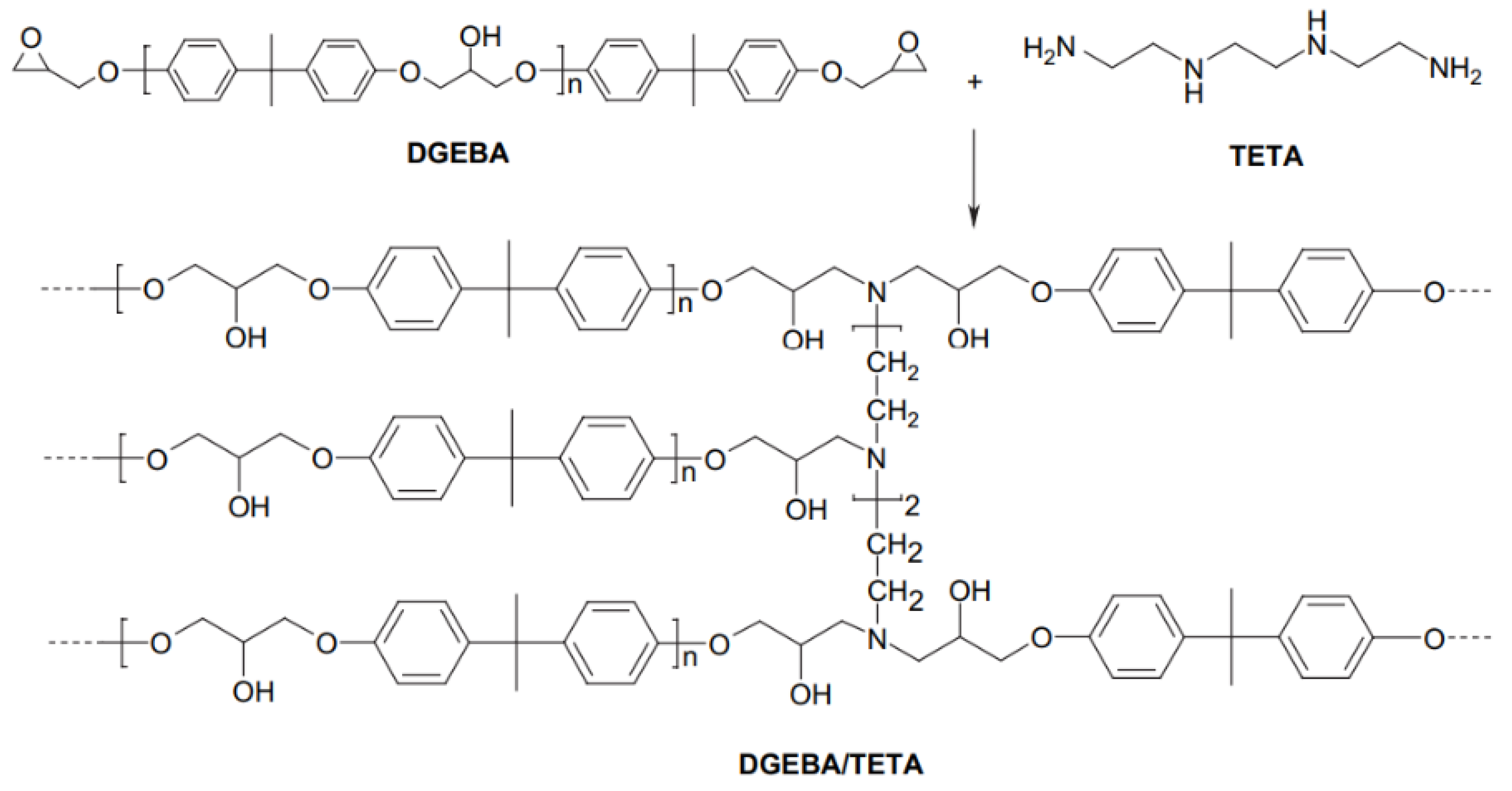



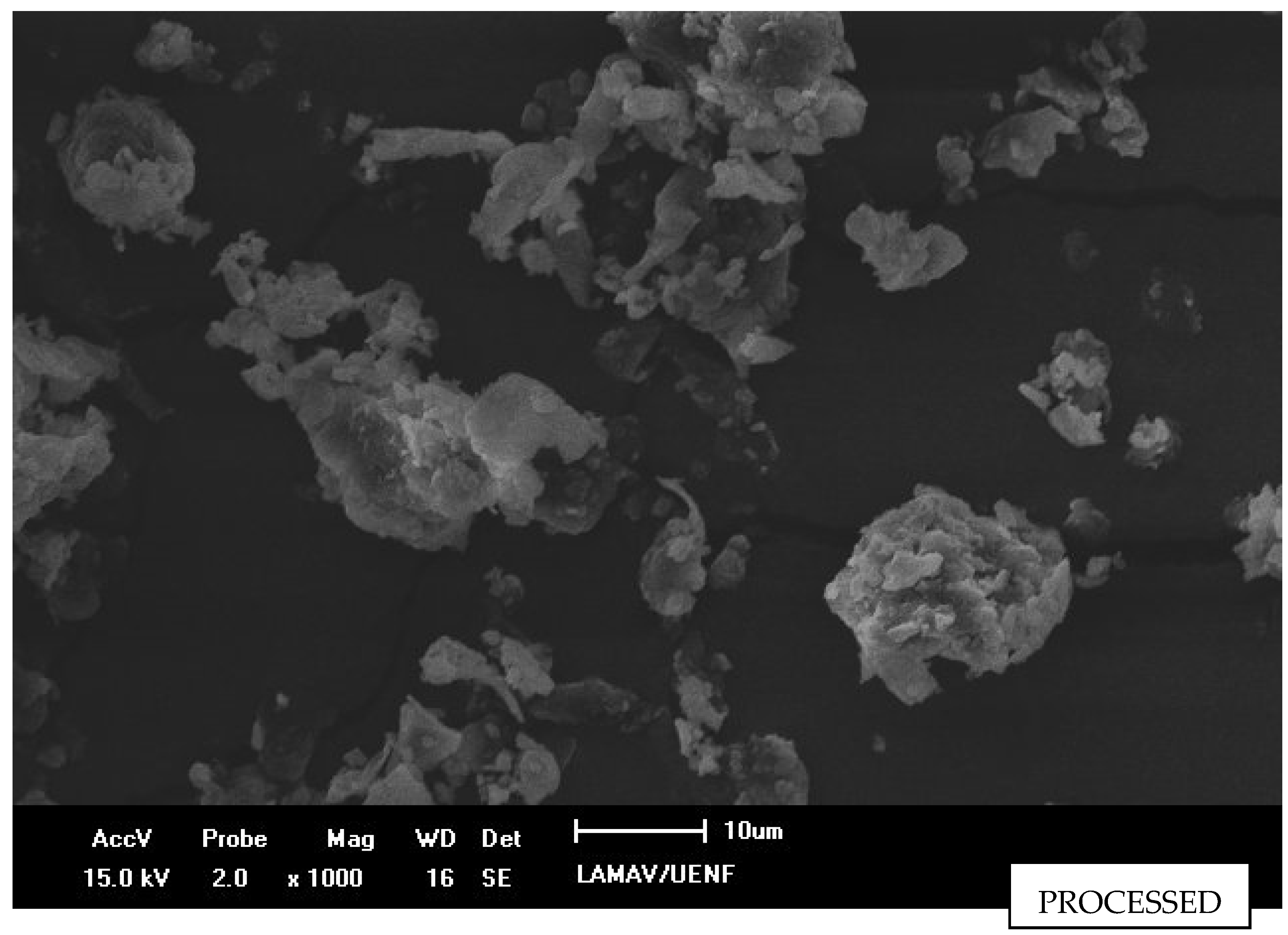


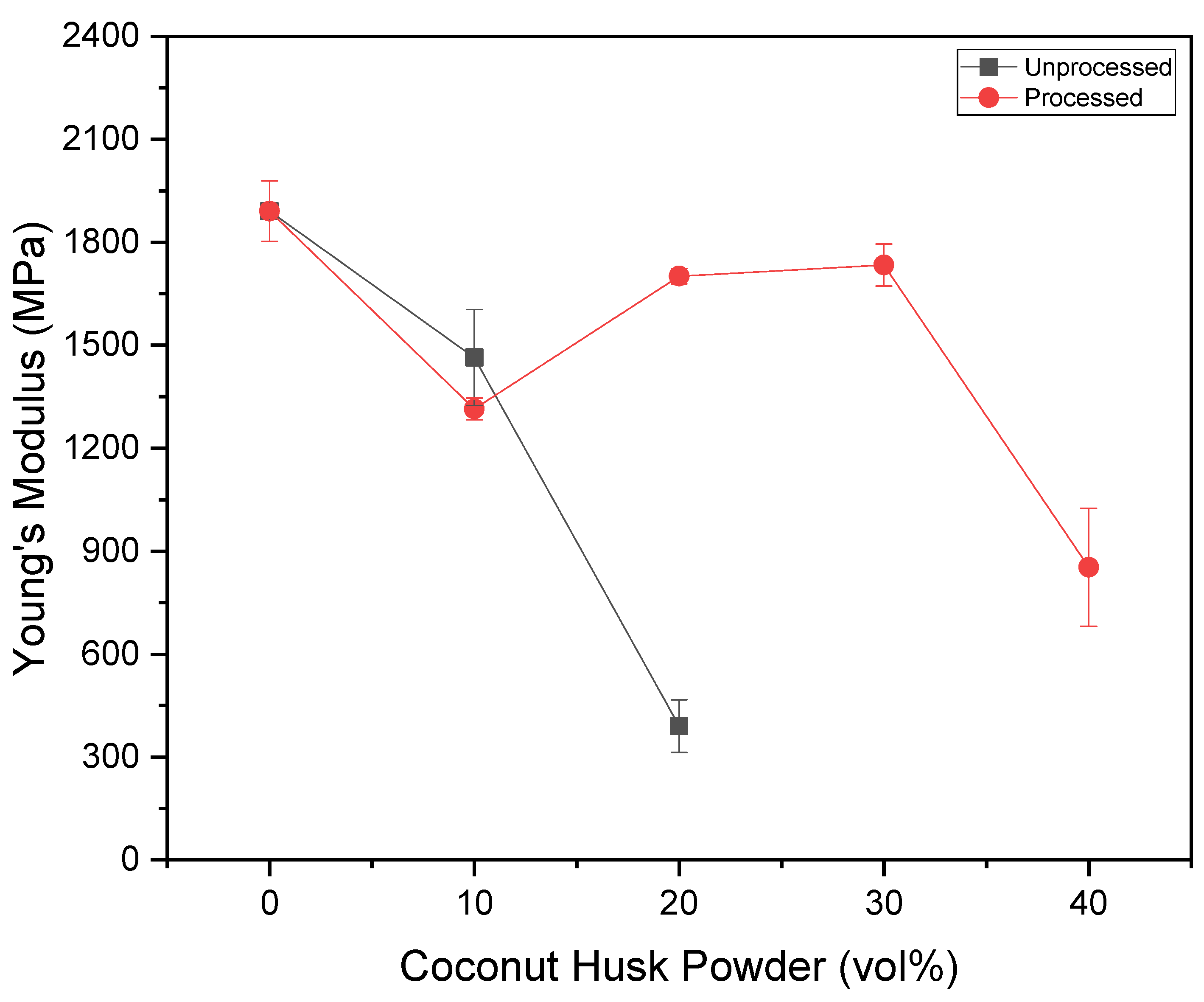
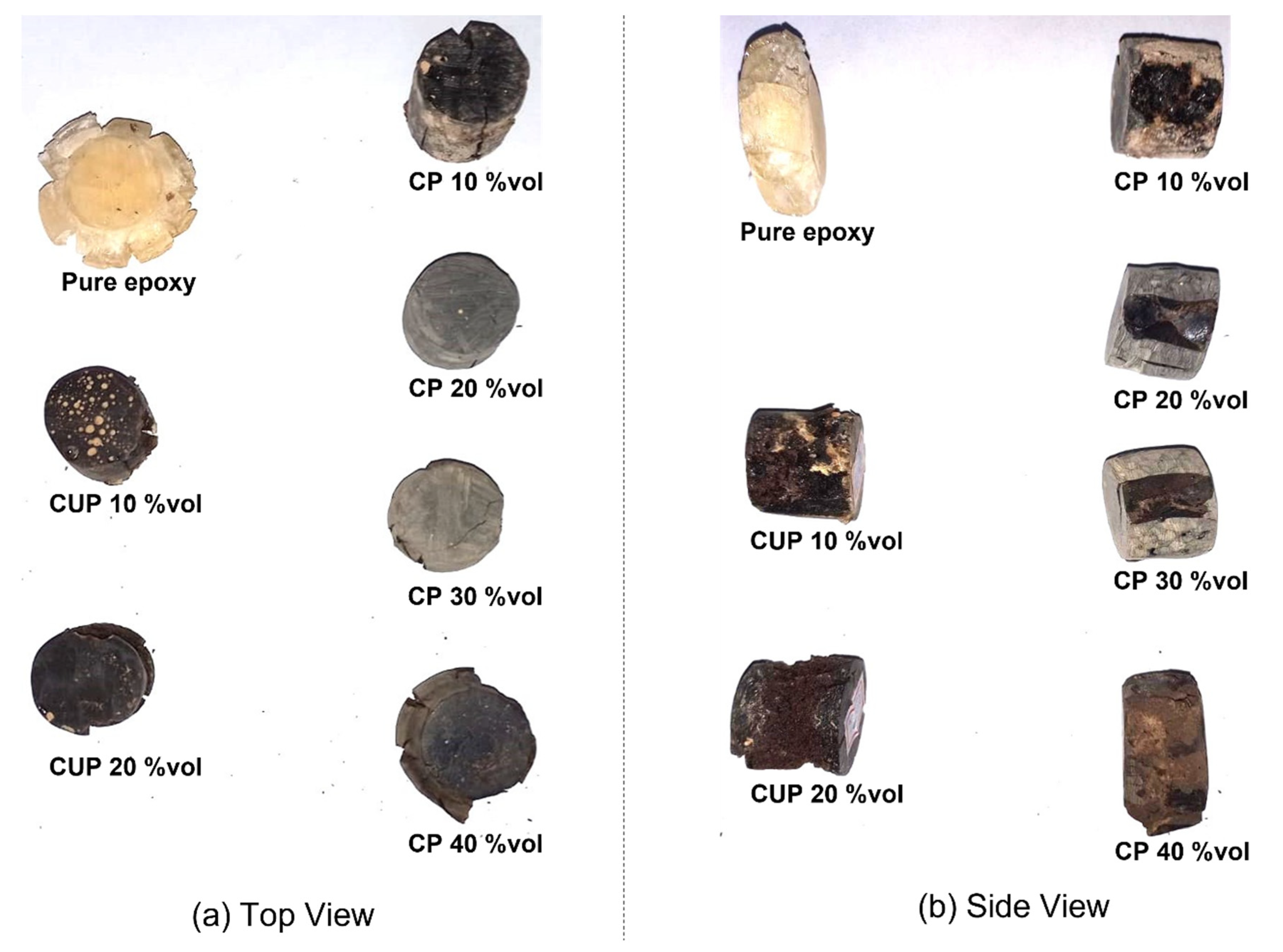
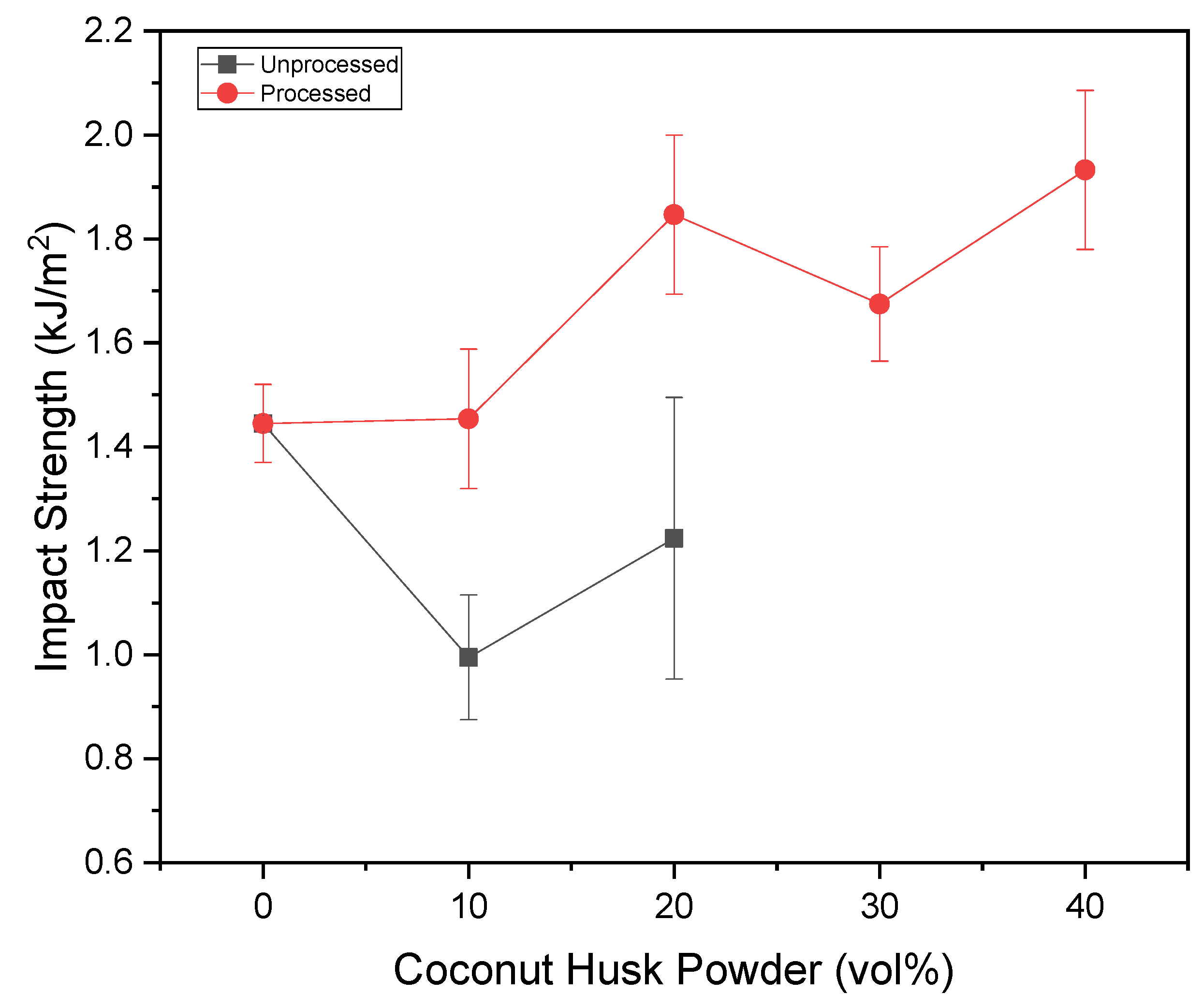
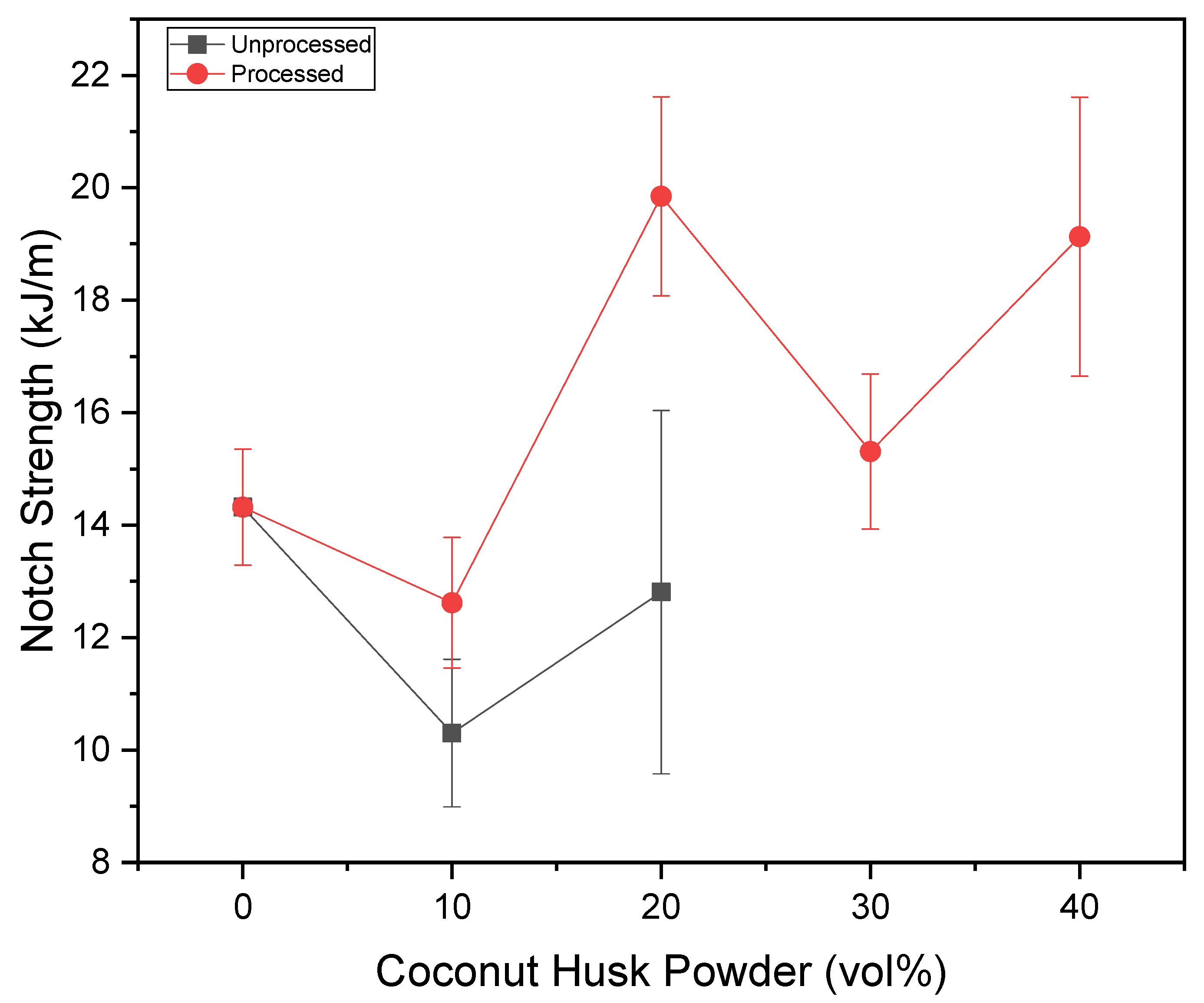
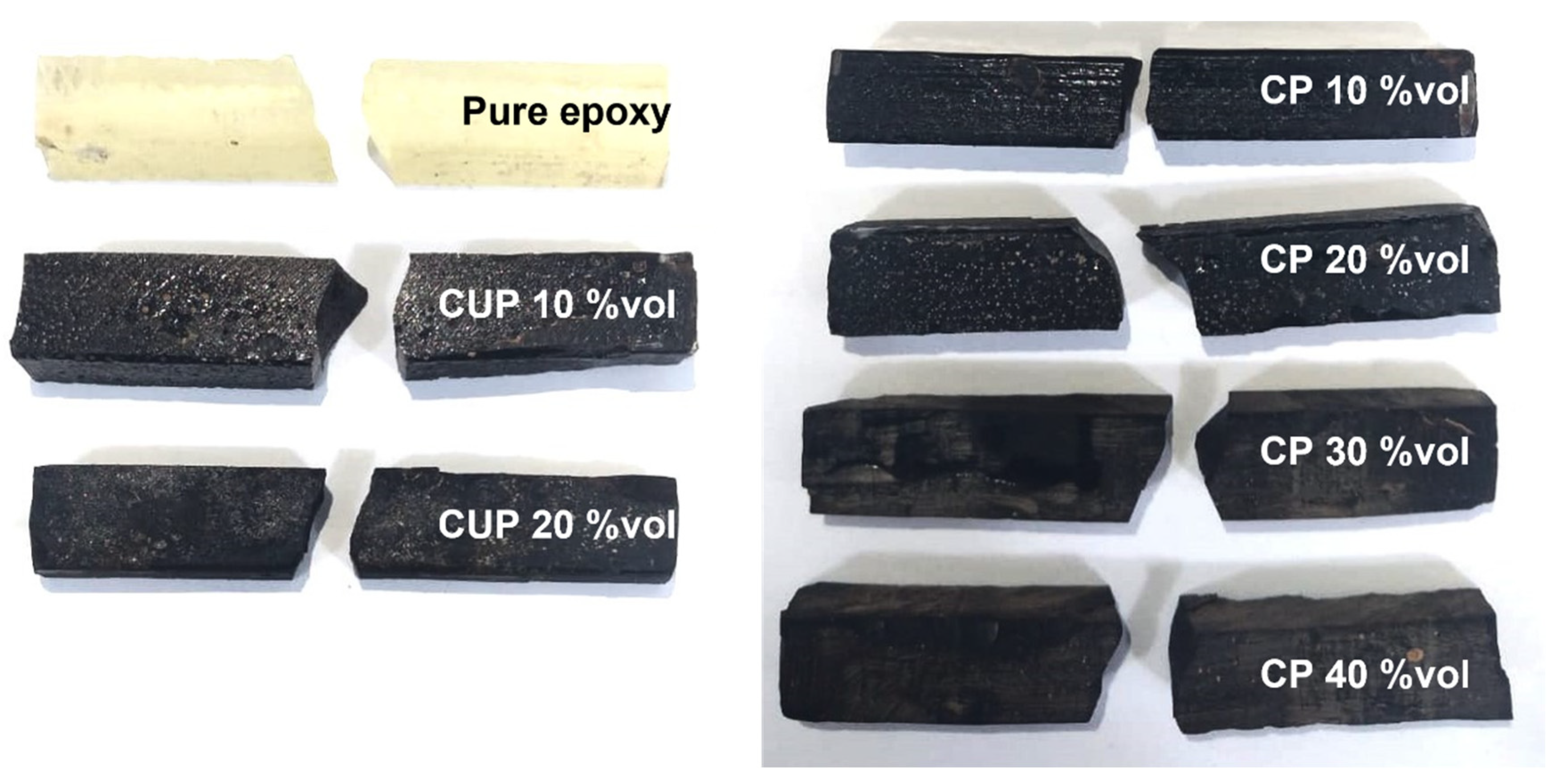

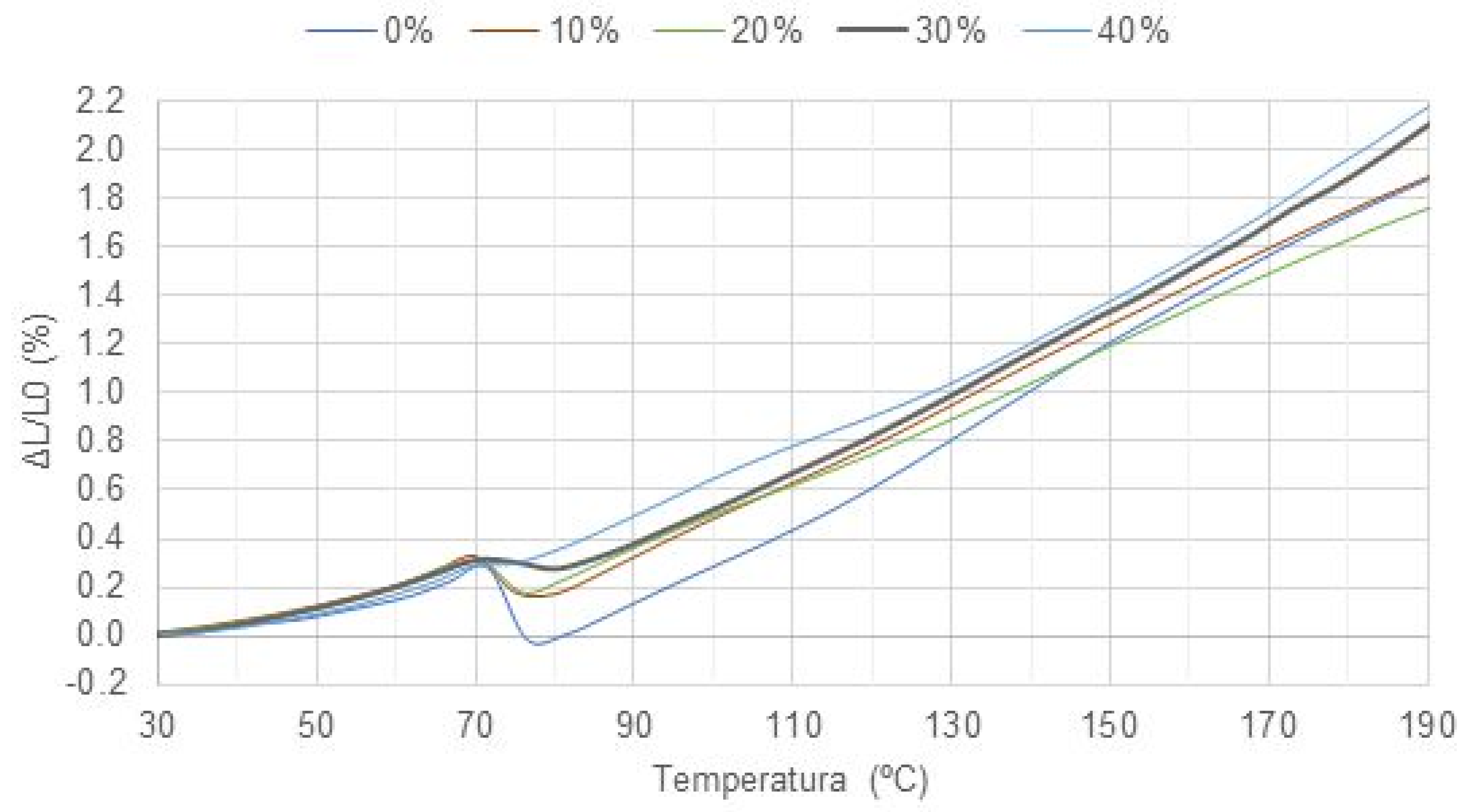
| Test | N° of Specimens | Parameters | Machine | Standard |
|---|---|---|---|---|
| Compression | 5 | Test speed: 2 mm/min Offset Yield: 0.2% | Universal Tensile Tester, Instron 5582 | ASTM E228-17 [34] |
| Impact (Izod) | 5 | Impact Energy: 11 J Impact Velocity: 3.5 m/s | Pendulum Impact tester, Pantec XC-50 | ASTM D256-10 [35] |
| Dilatometry | 1 | Temperature range: 300 to 460 k Heating rate: 2 K/min | Dilatometer Netzsch DIL 402 PC | ASTM D695-15 [36] |
| Filler (Volume) | Epoxy + Unprocessed Powder | Epoxy + Processed Powder | ||||
|---|---|---|---|---|---|---|
| YS (MPa) | YM (MPa) | CS (MPa) | YS (MPa) | YM (MPa) | CS (MPa) | |
| 0% | 67.6 ± 2.5 | 1891 ± 88 | 78.5 ± 1.6 | 67.6 ± 2.5 | 1891 ± 88 | 78.5 ± 1.6 |
| 10% | 48.1 ± 7.5 | 1464 ± 140 | 57.9 ± 4.1 | 90.4 ± 1.4 | 1314 ± 32 | 90.4 ± 1.4 |
| 20% | 17.5 ± 3.2 | 390 ± 77 | 20.1 ± 2.9 | 75.9 ± 3.3 | 1701 ± 22 | 82.7 ± 2.0 |
| 30% | - | - | - | 63.7 ± 6.0 | 1734 ± 61 | 73.4 ± 1.3 |
| 40% | - | - | - | 38.9 ± 6.1 | 853 ± 172 | 65.8 ± 8.7 |
| Filler (Volume) | Epoxy + Unprocessed Powder | Epoxy + Processed Powder | ||
|---|---|---|---|---|
| Impact Strength (kJ/m2) | Notch Strength (J/m) | Impact Strength (kJ/m2) | Notch Strength (J/m) | |
| 0% | 1.445 ± 0.075 | 14.32 ± 1.03 | 1.445 ± 0.075 | 14.32 ± 1.03 |
| 10% | 0.995 ± 0.120 | 10.30 ± 1.31 | 1.454 ± 0.134 | 12.62 ± 1.16 |
| 20% | 1.224 ± 0.271 | 12.81 ± 3.23 | 1.847 ± 0.153 | 19.85 ± 1.77 |
| 30% | 1.675 ± 0.110 | 15.31 ± 1.38 | ||
| 40% | 1.933 ± 0.153 | 19.13 ± 2.48 | ||
| Formulation | Average Expansion Rate before Peak | Peak Contraction | Average Expansion Rate after Peak | Total Expansion (ΔL/L0) |
|---|---|---|---|---|
| Pure epoxy | 0.0062/°C | 22.70% | 0.0179/°C | 1.87% |
| Epoxy + CUP 10vol% | 0.0065/°C | 5.58% | 0.0163/°C | 2.00% |
| Epoxy + CUP 20vol% | 0.0069/°C | 4.96% | 0.0168/°C | 2.07% |
| Epoxy + CP 10vol% | 0.0072/°C | 13.42% | 0.0157/°C | 1.88% |
| Epoxy + CP 20vol% | 0.0067/°C | 11.08% | 0.0141/°C | 1.76% |
| Epoxy + CP 30vol% | 0.0070/°C | 3.60% | 0.0160/°C | 2.09% |
| Epoxy + CP 40vol% | 0.0072/°C | 0.00% | 0.0162/°C | 2.17% |
Disclaimer/Publisher’s Note: The statements, opinions and data contained in all publications are solely those of the individual author(s) and contributor(s) and not of MDPI and/or the editor(s). MDPI and/or the editor(s) disclaim responsibility for any injury to people or property resulting from any ideas, methods, instructions or products referred to in the content. |
© 2023 by the authors. Licensee MDPI, Basel, Switzerland. This article is an open access article distributed under the terms and conditions of the Creative Commons Attribution (CC BY) license (https://creativecommons.org/licenses/by/4.0/).
Share and Cite
Coverdale Rangel Velasco, D.; Perissé Duarte Lopes, F.; Souza, D.; Colorado Lopera, H.A.; Neves Monteiro, S.; Fontes Vieira, C.M. Evaluation of Composites Reinforced by Processed and Unprocessed Coconut Husk Powder. Polymers 2023, 15, 1195. https://doi.org/10.3390/polym15051195
Coverdale Rangel Velasco D, Perissé Duarte Lopes F, Souza D, Colorado Lopera HA, Neves Monteiro S, Fontes Vieira CM. Evaluation of Composites Reinforced by Processed and Unprocessed Coconut Husk Powder. Polymers. 2023; 15(5):1195. https://doi.org/10.3390/polym15051195
Chicago/Turabian StyleCoverdale Rangel Velasco, David, Felipe Perissé Duarte Lopes, Djalma Souza, Henry Alonso Colorado Lopera, Sergio Neves Monteiro, and Carlos Maurício Fontes Vieira. 2023. "Evaluation of Composites Reinforced by Processed and Unprocessed Coconut Husk Powder" Polymers 15, no. 5: 1195. https://doi.org/10.3390/polym15051195
APA StyleCoverdale Rangel Velasco, D., Perissé Duarte Lopes, F., Souza, D., Colorado Lopera, H. A., Neves Monteiro, S., & Fontes Vieira, C. M. (2023). Evaluation of Composites Reinforced by Processed and Unprocessed Coconut Husk Powder. Polymers, 15(5), 1195. https://doi.org/10.3390/polym15051195








